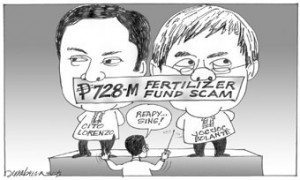POPE Benedict XVI celebrated his 84th birthday last Saturday and is set to mark the sixth year of his pontificate today, but the real papal milestone as far as most Catholics and the rest of the world are concerned is May 1, when his late predecessor, John Paul II, is beatified. Beatification allows a limited cult to be built around a beato as a prelude to canonization, which allows a wider, more universal veneration of the canonized. But it is remote that the cult around “Blessed” John Paul would be limited, say, to his old diocese of Krakow or even to the wider cult of his beloved homeland Poland or the Slavic world. The highly international character of the beatification ceremony and the tens of thousands of pilgrims coming from all corners of the globe reflect the universal reverence for “John Paul the Great.” In short, the beatification would be mere belated declaration of what’s already obtaining: John Paul is a cult figure; he’s an ikon.
Benedict himself would preside over the beatification ceremony. John Paul is a tough act to follow, and Benedict knows it. But he doesn’t set himself against his predecessor, in whose “Cabinet” he had served preeminently if controversially as chief doctrinal watchdog. He would rather portray himself as continuity, even a cherisher and promoter of John Paul’s legacy. He has in fact described the swift and sure papal transition as “a gift.” “I am really a debtor, a modest figure who is trying to continue what John Paul had accomplished as a giant.”
Benedict’s modesty is touching when contrasted with his achievements so far: the creation of more dioceses and sees to add to the 3,000 already existing worldwide covering 1.2 billion Catholics, the growing rapprochement with Orthodox Christians, the welcome extended to Anglicans worldwide turned off by their churches’ increasing liberalism, the firm diplomacy with Beijing over episcopal ordinations and his critique of Islam, violence and intolerance. He has restored the Latin Mass and reformed the Roman missal in what his annotator, the British Dominican theologian Aidan Nichols, has called a response to the crying need for a “re-enchantment of the liturgy.”
Astoundingly, in just six years, this Pope has already come up with three encyclicals and several books, including the sequel to his work on Jesus of Nazareth. Most of the books collect the talks he delivers during the Wednesday general papal audiences. Which means that Benedict continues to write his addresses despite his very hectic schedule!
To be sure, his pontificate has been affected by the child-abuse scandals in the US, Ireland and Germany as well as the regular tiff with the press over the Church’s stand on sexual morality. But he had consoled the victims in his US and Ireland visits, and pressed the German church to deal more firmly with the issue. It’s also true that certain sectors of the news media have been reductionist in reporting the very nuanced moral theological positions of the Church on sexual morality. One German paper has characterized the general press’ pooh-poohing and misreporting of the Church’s positions on condom, HIV-AIDS and sexual morality as one of “aggressive ignorance.”
But Benedict has been remarkably unflappable without appearing blasé. He has wisely focused his energies on remaking the Church according to the plan he and his predecessor had set out to do. If John Paul had led successfully the Church’s campaign against communism and the godless aspects of modernism, Benedict’s focus seems to be the consolidation of the forces of the Church against liberal intolerance and what he has famously called “the dictatorship of relativism.” As his Wednesday discourses indicate, his tack is to expound on the Bible and sacred tradition and the history of the Church in order to relate her teachings and age-old experience to the challenges of today. The campaign is one of renewal and consolidation. He tries to renew the Church from within, particularly the listless Church of Europe, while attracting other churches and lapsed Catholics to come back to the fold, an approach that resonates with the reference made by his favorite theologian, Saint Augustine, regarding the Church during the fourth century when Pax Romana was heading for decimation and disintegration—that “many outside seem to be inside, and many inside seem to be outside.” Seen in that context, all of the problems facing Benedict seem the requisite Lenten phase to Easter, the necessary prelude to a new apotheosis for the Church.
